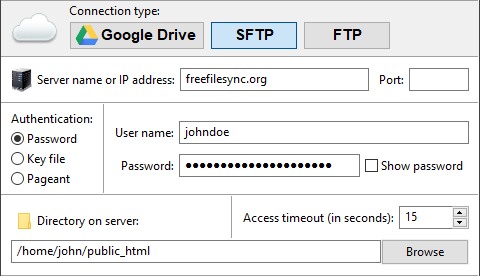
FreeFileSync Open Source File Synchronization
It looks like an ad blocker has blocked the ads.
 The FreeFileSync project is 100% dependent on ad revenue and donations to stay alive. Instead of the ads, and
after FreeFileSync has proven useful to you, please think about supporting with a donation.
The FreeFileSync project is 100% dependent on ad revenue and donations to stay alive. Instead of the ads, and
after FreeFileSync has proven useful to you, please think about supporting with a donation.
 The FreeFileSync project is 100% dependent on ad revenue and donations to stay alive. Instead of the ads, and
after FreeFileSync has proven useful to you, please think about supporting with a donation.
The FreeFileSync project is 100% dependent on ad revenue and donations to stay alive. Instead of the ads, and
after FreeFileSync has proven useful to you, please think about supporting with a donation.
FreeFileSync User Manual:
#Quick Start
Command Line
Scripting
Comparison Settings
Daylight Saving Time
Exclude Files
Expert Settings
External Applications
Macros
Performance
RealTimeSync
RTS: Run as Service
Schedule Batch Jobs
Synchronization Settings
(S)FTP Setup
Tips and Tricks
Variable Drive Letters
Versioning
Volume Shadow Copy
SFTP and FTP Setup
FreeFileSync supports synchronization with SFTP and FTP natively. Just enter your login information into the dialog shown for cloud folder selection:
Note
In case the (S)FTP server sets file modification times to the current time you can do a Compare by File Size as a workaround. Another solution is to set up the Two way variant and have the files with the newer dates be copied back from the server during the next synchronization.
In case the (S)FTP server sets file modification times to the current time you can do a Compare by File Size as a workaround. Another solution is to set up the Two way variant and have the files with the newer dates be copied back from the server during the next synchronization.
Configure SFTP for Best Performance
By default, FreeFileSync creates one connection to the server and uses one SFTP channel, i.e. only a single SFTP command can be sent and received at a time. Since most of this time is spent waiting due to the high latency of the remote connection, you can speed up reading large folder hierarchies by increasing both the connection and channel count.The folder reading time is reduced by a factor of N x M when using N connections with M channels each.
Example: 10 connections using 2 channels each can yield a 20 times faster folder reading.

- The creation of additional connections and channels takes time. If you are only scanning a small remote folder,
setting up too many connections and channels might actually slow the overall process down.
Creating extra connections is slower than creating extra channels.
- SFTP servers have internal limits on the number of allowed connections and channels.
Generally, servers expect one connection per user, so this number should be kept rather low.
If too many connections and channels are used, the server may decide to stop responding.
- Unlike connections, additional SFTP channels are (currently) only used during folder reading (comparison), but not during synchronization.
- Enable compression to improve performance if the connection to the SFTP server is slow and the data is mostly uncompressed (e.g. copying text files over a slow internet connection). However, if the connection is very fast (e.g. a local network), or the data is already compressed (e.g. zip files), the CPU overhead of the zlib compression algorithm might slow transfer times down and the option is better left unchecked.
Advice
Start with low numbers and make tests with different combinations of connections and channels for your particular SFTP synchronization scenario to see what gives the highest speed. Note, however, that FreeFileSync reuses existing SFTP connections/channels. Therefore, you should restart FreeFileSync before measuring SFTP speed.
Start with low numbers and make tests with different combinations of connections and channels for your particular SFTP synchronization scenario to see what gives the highest speed. Note, however, that FreeFileSync reuses existing SFTP connections/channels. Therefore, you should restart FreeFileSync before measuring SFTP speed.